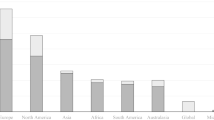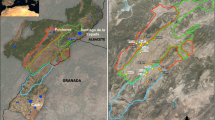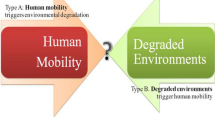Abstract
Negative environmental impacts of golf courses have received more attention than positive ecological contributions. We studied the mature tree communities and their legacy effect in a historical urban-fringe golf-course site in Hong Kong covering 170-ha with well-managed natural-cum-cultural landscape. Some 44.3 % of the site is covered mainly by large trees forming a mature peri-urban forest. The 94 species in 35 families offer a high species diversity exceeding local secondary and climax fengshui woodlands with notable rare and protected species. Tree species composition, richness and legacy effects brought by anthropogenic and natural factors were investigated by three habitats with varying naturalness and three golf courses with different age. Landscape zone is remarkably heterogeneous versus other microhabitats (fairway and woodland) and the heterogeneity of tree communities amongst the three courses is relatively weak. Synergistic operation of natural regeneration (natural legacy effect) and anthropogenic management (anthropogenic legacy effect) has fostered diversity accumulation. On the one hand, temporal changes in landscape fashion through a century and variations in site management have driven and maintained species diversity. On the other hand, the founder effect of inherited and cultivated species, as well as successful invasion and establishment of native species, have imposed floristic imprint and inertia on woodland habitat. The findings suggested that urban golf courses can serve as potential hotspots for biodiversity conservation within urban ecosystems.

Similar content being viewed by others
References
Agriculture, Fisheries and Conservation Department (2003) Rare and precious plants of Hong Kong. HKSAR Government, Hong Kong
Arrhenius O (1921) Species and area. J Ecol 9:95–99
Bannister MH (1965) Variation in the breeding system of Pinus radiata. In: Baker HG, Stebbins GL (eds) The genetics of colonizing species. Academic, New York, pp 353–374
Baris RD, Cohen SZ, Barnes NL, Lam J, Ma Q (2010) Quantitative analysis of over 20 years of golf course monitoring studies. Environ Toxicol Chem 29:1224–1236
Boone MD, Semlitsch RD, Mosby C (2008) Suitability of golf course ponds for amphibian metamorphosis when bullfrogs are removed. Conserv Biol 22:172–179
Bray JR, Curtis JT (1957) An ordination of upland forest communities of southern Wisconsin. Ecol Monogr 27:325–349
Briassoulis H (2010) Sorry golfers, this is not your spot! Exploring public opposition to golf development. J Sport Soc Issues 34:288–311
Burgin S, Wotherspoon D (2009) The potential for golf courses to support restoration of biodiversity for BioBanking offsets. Urban Ecosyst 12:145–155
Chai SL, Tanner EVJ (2011) 150-year legacy of land use on tree species composition in old-secondary forests of Jamaica. J Ecol 99:113–121
Chau KC, Marafa LM (1999) Vegetation chronosequence in Hong Kong: soil properties and successional development. Singap J Trop Geogr 20:24–35
Choi KY, Cheung RWM (2013) Landslide disaster prevention and mitigation through works in Hong Kong. J Rock Mech Geotech Eng 5:354–365
Clarke LW, Jenerette GD, Davila A (2013) The luxury of vegetation and the legacy of tree biodiversity in Los Angeles, CA. Landsc Urban Plan 116:48–59
Cohen S, Svrjcek A, Durborow T, Barnes NL (1999) Water quality impacts by golf courses. J Environ Qual 28:798–809
Colding J (2013) Local assessment of Stockholm: revisiting the Stockholm urban assessment. In: Elmqvist T, Fragkias M, Goodness J, Güneralp B, Marcotullio PJ, McDonald RI, Parnell S, Schewenius M, Seto KS, Wilkinson C (eds) Urbanization, biodiversity and ecosystem services: challenges and opportunities, a global assessment. Springer, Dordrecht, pp 313–335
Colding J, Folke C (2009) The role of golf courses in biodiversity conservation and ecosystem management. Ecosystems 12:191–206
Colding J, Lundberg J, Lundberg S, Andersson E (2009) Golf courses and wetland fauna. Ecol Appl 19:1481–1491
Connor EF, McCoy ED (1979) The statistics and biology of the species-area relationship. Am Nat 113:691–833
Corlett RT (1993) Reproductive phenology of Hong Kong shrubland. J Trop Ecol 9:501–510
Corlett RT (1999) Environmental forestry in Hong Kong: 1871–1997. For Ecol Manag 116:93–105
Corlett RT (2011) Seed dispersal in Hong Kong, China: past, present and possible futures. Integr Zool 6:97–109
Daley PA (1975) Man’s influence of the vegetation of Hong Kong. In: Thrower LB (ed) The vegetation of Hong Kong: its structure and change. Royal Asiatic Society, Hong Kong Branch, pp 44–56
Ditgen RS, Shepherd JD, Humphrey SR (2007) Big Cypress fox squirrels (Sciurus niger avicennia) diet, activity and habitat use on a golf course in Southwest Florida. Am Midl Nat 158:403–414
Dobbs EK, Potter DA (2016) Naturalized habitat on golf courses: source or sink for natural enemies and conservation biological control? Urban Ecosyst. doi:10.1007/s11252-015-0521-1
Dudgeon D, Corlett R (1994) Hills and streams: an ecology of Hong Kong. Hong Kong University Press, Hong Kong
Filipović V, Toor GS, Ondrašek G, Kodešová R (2015) Modeling water flow and nitrate-nitrogen transport on golf course under turfgrass. J Soils Sediments 15:1847–1859
Foley SM, Price SJ, Dorcas ME (2012) Nest-site selection and nest depredation of semi-aquatic turtles on golf courses. Urban Ecosyst 15:489–497
Forman TT (2014) Urban ecology: science of cities. Cambridge University Press, New York
Gange AC, Lindsay DE, Schofield JM (2003) The ecology of golf courses. Biologist 50:63–68
Geotechnical Engineering Office (2011) Technical guidelines on landscape treatment for slopes (GEO publication no.1/2011). Civil Engineering and Development Department, HKSAR Government, Hong Kong
Green BH, Marshall JC (1987) An assessment of the role of golf courses in Kent, England, in protecting wildlife and landscape. Landsc Urban Plan 14:143–154
Hammond RA, Hudson MD (2007) Environmental management of UK golf courses for biodiversity-attitudes and actions. Landsc Urban Plan 83:127–136
Hartley MJ (2002) Rationale and methods for conserving biodiversity in plantation forests. For Ecol Manag 155:81–95
Hau BCH, Corlett RT (2003) Factors affecting the early survival and growth of native tree seedlings planted on a degraded hillside grassland in Hong Kong, China. Restor Ecol 11:483–488
Hodgkison SC, Hero JM, Warnken J (2007a) The conservation value of suburban golf courses in a rapidly urbanising region of Australia. Landsc Urban Plan 79:323–337
Hodgkison SC, Hero JM, Warnken J (2007b) The efficacy of small-scale conservation efforts, as assessed on Australian golf courses. Biol Conserv 136:576–586
Hong Kong Government (1997) Forests and Countryside Ordinance (Cap. 96). HKSAR Government, Hong Kong
Hong Kong Herbarium (2012) Check list of Hong Kong plants 2012. Agriculture, Fisheries and Conservation Department, HKSAR Government, Hong Kong
Hong Kong Golf Club (2013) Annual report 2012. Hong Kong
Hudson MAR, Bird DM (2009) Recommendations for design and management of golf courses and green spaces based on surveys of breeding bird communities in Montreal. Landsc Urban Plan 92:335–346
Jackson DB, Kelly SD, Brown RD (2011) Design guidelines for integrating amphibian habitat into golf course landscapes. Landsc Urban Plan 103:156–165
Jim CY (1986) The country parks programme and country-side conservation in Hong Kong. Environmentalist 6:259–270
Jim CY (1993) Ecological rehabilitation of disturbed lands in the humid tropics. In: Parnham WE, Durana PJ, Hess AL (eds.) Improving degraded lands: Promising experiences from South China. Bishop Museum Bulletin in Botany 3, Bishop Museum, Honolulu, HI, pp 217–229
Jim CY (1998) Impacts of intensive urbanization on trees in Hong Kong. Environ Conserv 25:146–159
Jim CY (2000) The urban forestry programme in the heavily built-up milieu of Hong Kong. Cities 17:271–283
Johnson DE, Collins BJ (2001) Center parcs UK: leisure development which achieves biodiversity gains. Manag Leis 6:63–73
Kattel GR, Elkadi H, Meikle H (2013) Developing a complementary framework for urban ecology. Urban For Urban Gree 12:498–508
Kay J (1977) Trees on a golf course. Arboric J 3:203–207
Kwok HK, Corlett RT (2000) The bird communities of a natural secondary forest and a Lophostemon confertus plantation in Hong Kong, South China. For Ecol Manag 130:227–234
LeClerc JE, Che JPK, Swaddle JP, Cristol DA (2005) Reproductive success and developmental stability of eastern bluebirds on golf courses: evidence that golf courses can be productive. Wildl Soc Bull 33:483–493
Lee EWS, Hau BCH, Corlett RT (2005) Natural regeneration in exotic tree plantations in Hong Kong, China. For Ecol Manag 212:358–366
Lee EWS, Hau BCH, Corlett RT (2008) Seed rain and natural regeneration in Lophostemon confertus plantations in Hong Kong, China. New For 35:119–130
Leung FTY, Yan WM, Hau BCH, Tham LG (2015) Root systems of native shrubs and trees in Hong Kong and their effects on enhancing slope stability. Catena 125:102–110
Lim TK (2012) Edible medicinal and non-medicinal plants, volume 3: fruits. Springer, New York
Ling J, Shu J (2009) A profound analysis on prosperity of golf sport in the mainland of China. J Beijing Sport Univ 32:24–25
Lomolino MV (2001) The species-area relationship: new challenges for an old pattern. Prog Phys Geogr 25:1–21
Lugo AE (1997) The apparent paradox of reestablishing species richness on degraded lands with tree monocultures. For Ecol Manag 99:9–19
MacArthur RH, Wilson EO (1967) The theory of island biogeography. Princeton University Press, Princeton, NJ
Mackey MJ, Connette GM, Peterman WE, Semlitsch RD (2014) Do golf courses reduce the ecological value of headwater streams for salamanders in the southern Appalachian Mountains? Landsc Urban Plan 125:17–27
Neo H (2001) Sustaining the unsustainable? Golf in urban Singapore. Int J Sustain Dev World 8:191–202
Ng SC, Corlett RT (2002) The bad biodiversity: alien plant species in Hong Kong. Biodivers Sci 10:109–118
Parrotta JA, Turnbull JW, Jones N (1997) Catalyzing native forest regeneration on degraded tropical lands. For Ecol Manag 99:1–7
Pisces Conservation Ltd. (2004) Community analysis package 3.0. Lymington, UK
Porter EE, Bulluck J, Blair RB (2005) Multiple spatial-scale assessment of the conservation value of golf courses for breeding birds southwestern Ohio. Wildl Soc Bull 33:494–506
Soini K, Aakkula J (2007) Framing the biodiversity of agricultural landscape: the essence of local conceptions and constructions. Land Use Policy 24:311–321
Sorace A, Visentin M (2007) Avian diversity on golf courses and surrounding landscapes in Italy. Landsc Urban Plan 81:81–90
Hong Kong Herbarium & South China Botanical Garden (2007) Flora of Hong Kong volume 1. Agriculture, Fisheries and Conservation Department, HKSAR Government, Hong Kong
Hong Kong Herbarium & South China Botanical Garden (2008) Flora of Hong Kong volume 2. Agriculture, Fisheries and Conservation Department, HKSAR Government, Hong Kong
Hong Kong Herbarium & South China Botanical Garden (2009) Flora of Hong Kong volume 3. Agriculture, Fisheries and Conservation Department, HKSAR Government, Hong Kong
Hong Kong Herbarium & South China Botanical Garden (2011) Flora of Hong Kong volume 4. Agriculture, Fisheries and Conservation Department, HKSAR Government, Hong Kong
Stangel P (2006) Wildlife links: Improving golf’s environmental game. United States Golf Association, http://www.usga.org/turf/images/photos/wildlife_links_lo-res.pdf. Accessed 20 July 2015
Tanner RA, Gange AC (2005) Effects of golf courses on local biodiversity. Landsc Urban Plan 71:137–146
Terman MR (1997) Natural links: naturalistic golf courses as wildlife habitat. Landsc Urban Plan 38:183–197
Terman M (2000) Naturalistic golf courses: Stepping stones for nature. Conservation Ecology 4, http://www.consecol.org/vol4/iss1/resp4/. Accessed 25 August 2015
Tratalos J, Fuller RA, Warren PH, Davies RG, Gaston KJ (2007) Urban form, biodiversity potential and ecosystem services. Landsc Urban Plan 83:308–317
Tredici PD (2010) Spontaneous urban vegetation: reflections of change in a globalized world. Nat Cult 5:299–315
Turner IM, Corlett RT (1996) The conservation value of small, isolated fragments of lowland tropical forest. Trends Ecol Evol 11:330–333
Wan HB, Wong MK, Mok CY (1996) Pesticides in golf course waters associated with golf course runoff. B Environ Contam Tox 56:205–209
Wheeler K, Nauright J (2006) A global perspective on the environmental impact of golf. Sport Soc 9:427–443
Yang L, Liu N, Ren H, Wang J (2009) Facilitation by two exotic Acadia: Acacia auriculiformis and Acacia mangium as nurse plants in South China. For Ecol Manag 257:1786–1793
Yasuda M, Koike F (2006) Do golf courses provide a refuge for flora and fauna in Japanese urban landscapes? Landsc Urban Plan 75:58–68
Yasuda M, Koike F, Terman M (2008) How management practices affect arthropod communities on Japanese golf courses? Landsc Ecol Eng 4:133–138
Yip JKL, Ngar YN, Yip JY, Liu EKY, Lai PCC (2004) Venturing fung shui Woods. Friends of the Country Parks and Agriculture, Fisheries and Conservation Department, HKSAR Government, Hong Kong
Yip JY, Corlett RT, Dudgeon D (2006) Selecting small reserves in a human-dominated landscape: a case study of Hong Kong, China. J Environ Manag 78:86–96
Yuan SF, Ren H, Liu N, Wang J, Guo QF (2013) Can thinning of overstorey trees and planting of native tree saplings increase the establishment of native trees in exotic Acacia plantations in south China? J Trop For Sci 25:79–95
Zhang H, Chu LM (2013) Changes in soil seed bank composition during early succession of rehabilitated quarries. Ecol Eng 55:43–50
Zhang H, Jim CY (2013) Species adoption for sustainable forestry in Hong Kong’s degraded countryside. Int J Sustain Dev World 20:484–503
Zhang H, Zhuang X, Chu LM (2013) Plant recruitment in early development stages on rehabilitated quarries in Hong Kong. Restor Ecol 21:166–173
Zhuang X (1993) Forest succession in Hong Kong. Dissertation, University of Hong Kong
Zhuang X (1997) Rehabilitation and development of forest on degraded hills of Hong Kong. For Ecol Manag 99:197–201
Zhuang X, Corlett RT (1996) The conservation status of Hong Kong’s tree flora. Chin Biodiversity 4(S):36–43
Zhuang X, Corlett RT (1997) Forest and forest succession in Hong Kong, China. J Trop Ecol 13:857–866
Zhuang X, Yau ML (1999) The role of plantations in restoring degraded lands in Hong Kong. In: Wong MH, Wong JWC, Baker AJM (eds) Remediation and management of degraded lands. Lewis Publishers, Boca Raton, FL, pp 201–208
Zuo K, Xu G, Li Z, Liu Z (2009) The analysis and prediction of Chinese golf course development model. Pratacultural Sci 26:221–226
Acknowledgments
We acknowledge with gratitude the assistance kindly provided by the manager and staff of the Hong Kong Golf Club.
Author information
Authors and Affiliations
Corresponding author
Additional information
Highlights
Hitherto neglected ecological contributions of golf courses deserve detailed study
Mature peri-urban forest in a historical golf course in Hong Kong was evaluated
Synergistic management input and natural regeneration determine tree diversity
Founder effect of inherited and planted species imposes floristic imprint and inertia
Spatial-temporal varied naturalistic-ecological approaches enhance golf course ecology
Appendix
Appendix
Rights and permissions
About this article
Cite this article
Jim, C.Y., Chen, W.Y. Legacy effect of trees in the heritage landscape of a peri-urban golf course. Urban Ecosyst 19, 1717–1734 (2016). https://doi.org/10.1007/s11252-016-0562-0
Published:
Issue Date:
DOI: https://doi.org/10.1007/s11252-016-0562-0




